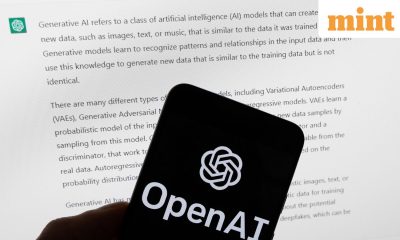

Metaverse
AI could accelerate scientific fraud as well as progress – Crypto News
The aim of the session, organised by the Royal Society in partnership with Humane Intelligence, an American non-profit, was to break those guardrails. Some results were merely daft: one participant got the chatbot to claim ducks could be used as indicators of air quality (apparently, they readily absorb lead). Another prompted it to claim health authorities back lavender oil for treating long covid. (They do not.) But the most successful efforts were those that prompted the machine to produce the titles, publication dates and host journals of non-existent academic articles. “It’s one of the easiest challenges we’ve set,” said Jutta Williams of Humane Intelligence.
AI has the potential to be a big boon to science. Optimists talk of machines producing readable summaries of complicated areas of research; tirelessly analysing oceans of data to suggest new drugs or exotic materials and even, one day, coming up with hypotheses of their own. But AI comes with downsides, too. It can make it easier for scientists to game the system, or even commit outright fraud. And the models themselves are subject to subtle biases.
Start with the simplest problem: academic misconduct. Some journals allow researchers to use LLMs to help write papers, provided they say as much. But not everybody is willing to admit to it. Sometimes, the fact that LLMs have been used is obvious. Guillaume Cabanac, a computer scientist at the University of Toulouse, has uncovered dozens of papers that contain phrases such as “regenerate response”—the text of a button in some versions of ChatGPT that commands the program to rewrite its most recent answer, presumably copied into the manuscript by mistake.
The scale of the problem is impossible to know. But indirect measures can shed some light. In 2022, when LLMs were available only to those in the know, the number of research-integrity cases investigated by Taylor and Francis, a big publisher of scientific papers, rose from around 800 in 2021 to about 2,900. Early figures from 2023 suggest the number was on course to double. One possible telltale is odd synonyms: “haze figuring” as another way to say “cloud computing”, for example, or “counterfeit consciousness” instead of “AI”.
Even honest researchers could find themselves dealing with data that has been polluted by AI. Last year Robert West and his students at the Swiss Federal Institute of Technology enlisted remote workers via Mechanical Turk, a website which allows users to list odd jobs, to summarise long stretches of text. In a paper published in June, albeit one that has not yet been peer-reviewed, the team revealed that over a third of all the responses they received had been produced with the help of chatbots.
Dr West’s team was able to compare the responses they received with another set of data that had been generated entirely by humans, leaving them well-placed to detect the deception. Not all scientists who use Mechanical Turk will be so fortunate. Many disciplines, particularly in the social sciences, rely on similar platforms to find respondents willing to answer questionnaires. The quality of their research seems unlikely to improve if many of the responses come from machines rather than real people. Dr West is now planning to apply similar scrutiny to other crowdsourcing platforms he prefers not to name.
It is not just text that can be doctored. Between 2016 and 2020, Elisabeth Bik, a microbiologist at Stanford University, and an authority on dodgy images in scientific papers, identified dozens of papers containing images that, despite coming from different labs, seemed to have identical features. Over a thousand other papers have since been identified, by Dr Bik and others. Dr Bik’s best guess is that the images were produced by AI, and created deliberately to support a paper’s conclusions.
For now, there is no way to reliably identify machine-generated content, whether it is images or words. In a paper published last year Rahul Kumar, a researcher at Brock University, in Canada, found that academics could correctly spot only around a quarter of computer-generated text. AI firms have tried embedding “watermarks”, but these have proved easy to spoof. “We might now be at the phase where we no longer can distinguish real from fake photos,” says Dr Bik.
Producing dodgy papers is not the only problem. There may be subtler issues with AI models, especially if they are used in the process of scientific discovery itself. Much of the data used to train them, for instance, will by necessity be somewhat old. That risks leaving models stuck behind the cutting edge in fast-moving fields.
Another problem arises when AI models are trained on AI-generated data. Training a machine on synthetic MRI scans, for example, can get around issues of patient confidentiality. But sometimes such data can be used unintentionally. LLMs are trained on text scraped from the internet. As they churn out more such text, the risk of LLMs inhaling their own outputs grows.
That can cause “model collapse”. In 2023 Ilia Shumailov, a computer scientist at the University of Oxford, co-authored a paper (yet to be peer-reviewed) in which a model was fed handwritten digits and asked to generate digits of its own, which were fed back to it in turn. After a few cycles, the computer’s numbers became more or less illegible. After 20 iterations, it could produce only rough circles or blurry lines. Models trained on their own results, says Dr Shumailov, produce outputs that are significantly less rich and varied than their training data.
Some worry that computer-generated insights might come from models whose inner workings are not understood. Machine-learning systems are “black boxes” that are hard for humans to disassemble. Unexplainable models are not useless, says David Leslie at the Alan Turing Institute, an AI-research outfit in London, but their outputs will need rigorous testing in the real world. That is perhaps less unnerving than it sounds. Checking models against reality is what science is supposed to be about, after all. Since no one fully understands how the human body works, for instance, new drugs must be tested in clinical trials to figure out whether they work.
For now, at least, questions outnumber answers. What is certain is that many of the perverse incentives currently prevalent in science are ripe for exploitation. The emphasis on assessing academic performance by how many papers a researcher can publish, for example, acts as a powerful incentive for fraud at worst, and for gaming the system at best. The threats that machines pose to the scientific method are, at the end of the day, the same ones posed by humans. AI could accelerate the production of fraud and nonsense just as much as it accelerates good science. As the Royal Society has it, nullius in verba: take nobody’s word for it. No thing’s, either.
Curious about the world? To enjoy our mind-expanding science coverage, sign up to Simply Science, our weekly subscriber-only newsletter.
Correction (February 6th 2024): An earlier version of this piece misstated the number of research-integrity cases investigated by Taylor and Francis in 2021. Sorry.
© 2024, The Economist Newspaper Limited. All rights reserved. From The Economist, published under licence. The original content can be found on www.economist.com
Milestone Alert!
Livemint tops charts as the fastest growing news website in the world 🌏 Click here to know more.
Unlock a world of Benefits! From insightful newsletters to real-time stock tracking, breaking news and a personalized newsfeed – it’s all here, just a click away! Login Now!
Download The Mint News App to get Daily Market Updates.
Published: 02 Apr 2024, 05:00 PM IST
-

 Cryptocurrency7 days ago
Cryptocurrency7 days agoIlluminating progress: Is a $140K income ‘poor’? – Crypto News
-
Technology6 days ago
Crypto Lawyer Bill Morgan Praises Ripple’s Multi-Chain Strategy as RLUSD Hits $1.1B – Crypto News
-

 Blockchain5 days ago
Blockchain5 days agoAnalyst Reveals What You Should Look Out For – Crypto News
-

 Technology1 week ago
Technology1 week agoSamsung Galaxy S25 Ultra 5G for under ₹80,000 on Flipkart? Here’s how the deal works – Crypto News
-

 others7 days ago
others7 days agoGold holds strong at $4,200 as Fed-cut anticipation builds – Crypto News
-
Cryptocurrency1 week ago
Crypto Platform Polymarket Relaunches in U.S. Following CFTC Approval – Crypto News
-

 Cryptocurrency1 week ago
Cryptocurrency1 week agoUK recognises crypto as property in major digital asset shift – Crypto News
-
others1 week ago
Bitcoin Price Forecast as BlackRock Sends $125M in BTC to Coinbase — Is a Crash Inevitable? – Crypto News
-

 Cryptocurrency7 days ago
Cryptocurrency7 days agoCrypto Holiday Gift Guide 2025 – Crypto News
-
others5 days ago
Breaking: Labor Department Cancels October PPI Inflation Report Ahead of FOMC Meeting – Crypto News
-
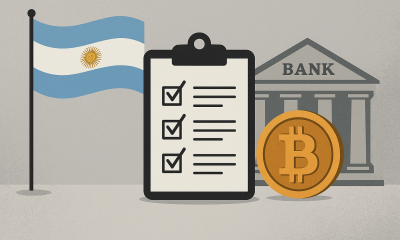
 Cryptocurrency5 days ago
Cryptocurrency5 days agoArgentina moves to reshape crypto rules as banks prepare for Bitcoin services – Crypto News
-

 Blockchain4 days ago
Blockchain4 days agoStripe and Paradigm Open Tempo Blockchain Project to Public – Crypto News
-
others1 week ago
$12T Charles Schwab to Launch Bitcoin and Ethereum Trading in Early 2026, CEO Confirms – Crypto News
-

 Cryptocurrency1 week ago
Cryptocurrency1 week ago‘Get it done on time’ – Lawmakers push regulators on GENIUS Act rollout – Crypto News
-
Business1 week ago
Crypto Platform Polymarket Relaunches in U.S. Following CFTC Approval – Crypto News
-

 Technology1 week ago
Technology1 week agoWorking on a screen all day? These 8 LED monitors in Dec 2025 are kinder on your eyes – Crypto News
-
others7 days ago
Morgan Stanley Turns Bullish, Says Fed Will Cut Rates by 25bps This Month – Crypto News
-

 Cryptocurrency7 days ago
Cryptocurrency7 days agoFlorida Appeals Court Revives $80M Bitcoin Theft – Crypto News
-

 Cryptocurrency1 week ago
Cryptocurrency1 week agoRipple CTO Shares Hilarious Email from Jed McCaleb Impersonator – Crypto News
-
Business1 week ago
Senator Tim Scott Floats December 17 and 18 For Crypto Market Bill Markup – Crypto News
-

 Cryptocurrency1 week ago
Cryptocurrency1 week agoBTC staking platform Babylon teams up with Aave for Bitcoin-backed DeFi insurance – Crypto News
-

 Blockchain1 week ago
Blockchain1 week agoSolana (SOL) Cools Off After Rally While Market Eyes a Resistance Break – Crypto News
-
others1 week ago
XRP Price Prediction As Spot ETF Inflows Near $1 Billion: What’s Next? – Crypto News
-

 others1 week ago
others1 week agoThe rally to 7120 continues – Crypto News
-

 Blockchain7 days ago
Blockchain7 days agoBitcoin Buries The Tulip Myth After 17 Years: Balchunas – Crypto News
-

 Cryptocurrency6 days ago
Cryptocurrency6 days agoWhy Ethereum strengthens despite whale selling – Inside Asia premium twist – Crypto News
-

 others6 days ago
others6 days agoNasdaq futures hold key structure as price compresses toward major resistance zones – Crypto News
-

 others6 days ago
others6 days agoNasdaq futures hold key structure as price compresses toward major resistance zones – Crypto News
-

 Blockchain4 days ago
Blockchain4 days agoBMW Helps JPMorgan Drive Blockchain-Based FX Payments – Crypto News
-

 Blockchain1 week ago
Blockchain1 week agoLedger Finds Chip Flaw Allowing Complete Phone Takeover – Crypto News
-
Business1 week ago
Kalshi, Robinhood and Crypto com Face Cease & Desist Order in Connecticut – Crypto News
-
Business1 week ago
What’s Next for Dogecoin Price After Whales Scoop 480M DOGE? – Crypto News
-
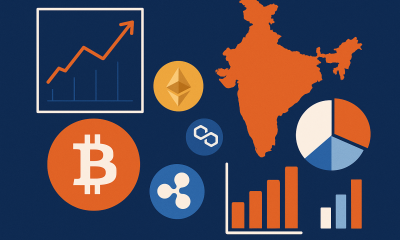
 Cryptocurrency1 week ago
Cryptocurrency1 week agoCoinDCX data reveals India’s rising appetite for diversified digital assets – Crypto News
-

 Technology1 week ago
Technology1 week agoCloudflare Resolved Services Issues Caused by Software Update – Crypto News
-
others1 week ago
Colombia Consumer Price Index (YoY) below forecasts (5.45%) in November: Actual (5.3%) – Crypto News
-
Technology1 week ago
Solana Price Outlook: Reversal at Key Support Could Lead to $150 Target – Crypto News
-

 Technology1 week ago
Technology1 week agoFrom security camera to gaming hub: 6 Easy tricks to make your old smartphone genuinely useful again – Crypto News
-
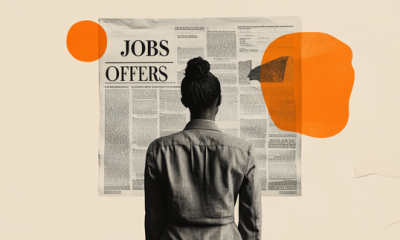
 others1 week ago
others1 week agoCanadian Dollar soars after upbeat labor report – Crypto News
-
others1 week ago
$1.3T BPCE To Roll Out Bitcoin, Ethereum and Solana Trading For Clients – Crypto News
-

 others6 days ago
others6 days agoStocks survive PCE and consumer data – FOMC too? – Crypto News
-

 Cryptocurrency6 days ago
Cryptocurrency6 days agoThursday links: Prediction markets, agent hackers, quantum risks – Crypto News
-

 Technology6 days ago
Technology6 days agoStarlink India pricing revealed: How much does monthly plan cost and what are its benefits? – Crypto News
-

 Cryptocurrency1 week ago
Cryptocurrency1 week agoCayman Islands sees rising Web3 foundation activity – Crypto News
-

 Technology1 week ago
Technology1 week agoApple Watch’s latest update drops a lifesaving feature for Indian users: here’s how it works – Crypto News
-
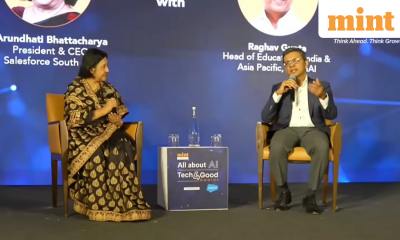
 Metaverse1 week ago
Metaverse1 week agoBetter Tomorrow: How OpenAI is reimagining education and inclusion for the digital age – Crypto News
-
Business1 week ago
Bitcoin, ETH, XRP, SOL’s Max Pain Price as Over $4B Options to Expire – Crypto News
-
Business1 week ago
Is ZCash Price Set for a Bigger Rally After Its 10% Surge on the Bitget Listing? – Crypto News
-
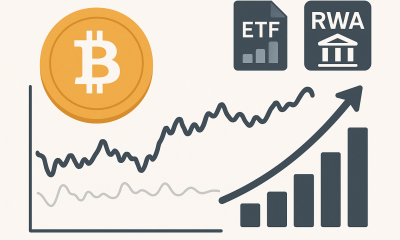
 Cryptocurrency1 week ago
Cryptocurrency1 week agoGlassnode report reveals Bitcoin’s growing stability amid ETF activity and RWA expansion – Crypto News
-
Technology1 week ago
Peter Brandt Hints at Further Downside for Bitcoin After Brief Rebound – Crypto News
-
others7 days ago
United States Consumer Credit Change came in at $9.18B, below expectations ($10.5B) in October – Crypto News







